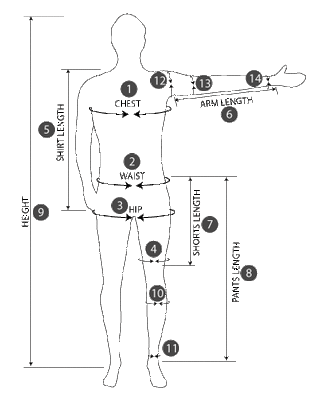Willix introduced its new PowerFit patterns and seams for compression garments like rashguard, cycling jerseys, trisuits, arm warmers, and compression calf. PowerFit style implements the following construction principles of Lycra Power™:
1. Garment must use a certain percentage of spandex fiber.
2. Fabric must be cut and sewn with high power direction perpendicular to the muscle group.
3. The primary body of the garment must use spandex fabric (exclusive of trims and inserts).
4. To provide adequate comfort, fit and durability only spandex shall be used in the waistband and trims. The use of generic elastane or rubber garter shall be avoided.
5. Seams and waistbands must stretch with the garment, matching the fabric's extensibility. Seams or waistbands should not block elongation of the fabric, which would prevent proprioceptive effects.
1. Garment must use a certain percentage of spandex fiber.
2. Fabric must be cut and sewn with high power direction perpendicular to the muscle group.
3. The primary body of the garment must use spandex fabric (exclusive of trims and inserts).
4. To provide adequate comfort, fit and durability only spandex shall be used in the waistband and trims. The use of generic elastane or rubber garter shall be avoided.
5. Seams and waistbands must stretch with the garment, matching the fabric's extensibility. Seams or waistbands should not block elongation of the fabric, which would prevent proprioceptive effects.
How To Get The Best Fit
There are basically 3 types of fit:
1) Traditional Fit
2) Regular T-Shirt Fit
3) Compression Fit
TRADITIONAL FIT
The traditional or skin-tight fit is commonly for enthusiasts in surfing, skiing, diving, and mixed martial arts. There is almost zero compression as the garment is cut exactly as the body measurement.
REGULAR T-SHIRT FIT
The regular T-shirt fit is similar to a regular t-shirt fit for the casual swimmer, beachgoer, or someone needing all day comfort and versatility. A more recently developed concept, these regular-fit rashguard shirts are more generously cut giving 10% allowance to the body measurement. The interest in this type of rash guard stems primarily from the desire for sun protection and they are appropriate for most casual occasions either in or out of the water.
COMPRESSION FIT
The compression fit shirts are 5% to 20% narrower than the horizontal measurement of your body. This fit exerts a subtle force on the skin that is equivalent to 1-foot water pressure. This pressure, although almost unnoticeable, is believed to have a beneficial effect similar to aquatic therapy.
1) Traditional Fit
2) Regular T-Shirt Fit
3) Compression Fit
TRADITIONAL FIT
The traditional or skin-tight fit is commonly for enthusiasts in surfing, skiing, diving, and mixed martial arts. There is almost zero compression as the garment is cut exactly as the body measurement.
REGULAR T-SHIRT FIT
The regular T-shirt fit is similar to a regular t-shirt fit for the casual swimmer, beachgoer, or someone needing all day comfort and versatility. A more recently developed concept, these regular-fit rashguard shirts are more generously cut giving 10% allowance to the body measurement. The interest in this type of rash guard stems primarily from the desire for sun protection and they are appropriate for most casual occasions either in or out of the water.
COMPRESSION FIT
The compression fit shirts are 5% to 20% narrower than the horizontal measurement of your body. This fit exerts a subtle force on the skin that is equivalent to 1-foot water pressure. This pressure, although almost unnoticeable, is believed to have a beneficial effect similar to aquatic therapy.
Getting the best fit for your compression shirt or short is sometimes tricky. The idea is to make the fabric a little narrower than your body to make it fit with a comfortable compression.
Usually, what is made narrower is the horizontal dimension of the garment. The ratio between the horizontal dimension of the garment and the body is called the compression ratio factor (or CRF). This usually ranges from 5 to 20%, depending on the stretchability of the fabric. The more stretchable the fabric, the higher is the compression ratio.
A 15% to 20% CRF for shirt will make the wearer feel as if he is submerged in water up to his chin level. A lower CRF will have minimal compression but will just serve as aesthetically pleasing tight-fit shirt.
If you order compression clothing, you will need to measure the following:
1) For short sleeve shirts, measure POINTS 1, 2, 3, and 5. If long sleeve shirt, measure additional POINTS like 6, 12, 13, and 14.
2) For shorts, measure POINTS 2, 3, 4, and 7. If long pants, measure additional POINTS like 8, 10, and 11.
Usually, what is made narrower is the horizontal dimension of the garment. The ratio between the horizontal dimension of the garment and the body is called the compression ratio factor (or CRF). This usually ranges from 5 to 20%, depending on the stretchability of the fabric. The more stretchable the fabric, the higher is the compression ratio.
A 15% to 20% CRF for shirt will make the wearer feel as if he is submerged in water up to his chin level. A lower CRF will have minimal compression but will just serve as aesthetically pleasing tight-fit shirt.
If you order compression clothing, you will need to measure the following:
1) For short sleeve shirts, measure POINTS 1, 2, 3, and 5. If long sleeve shirt, measure additional POINTS like 6, 12, 13, and 14.
2) For shorts, measure POINTS 2, 3, 4, and 7. If long pants, measure additional POINTS like 8, 10, and 11.




